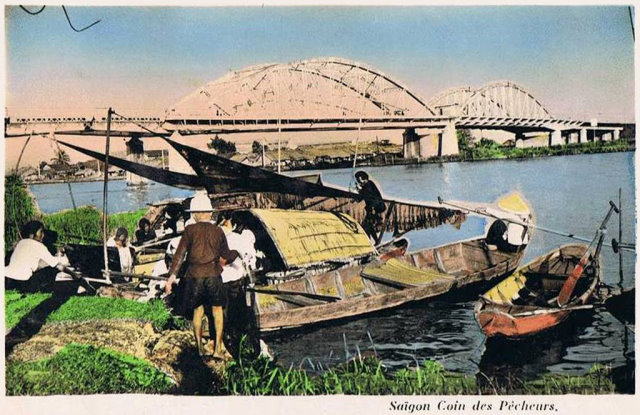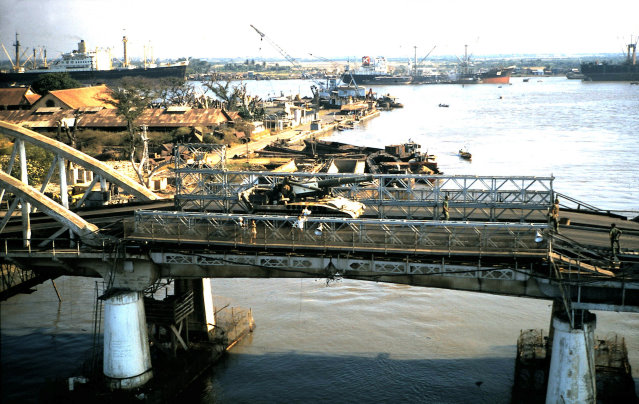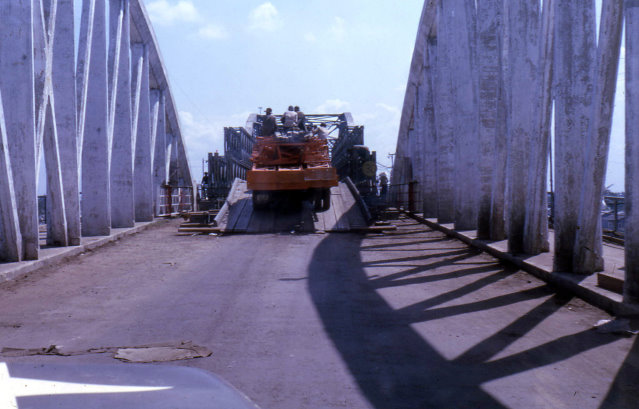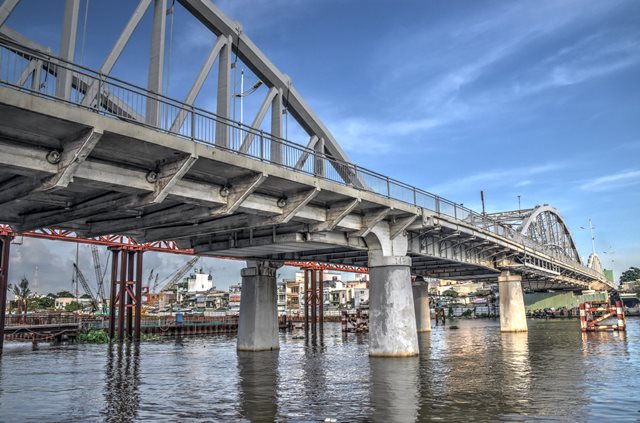We Recommend:
Bach Steel - Experts at historic truss bridge restoration.
BridgeHunter.com Phase 1 is released to the public! - Visit Now
Cầu Tân Thuận (Tan Thuan Bridge)
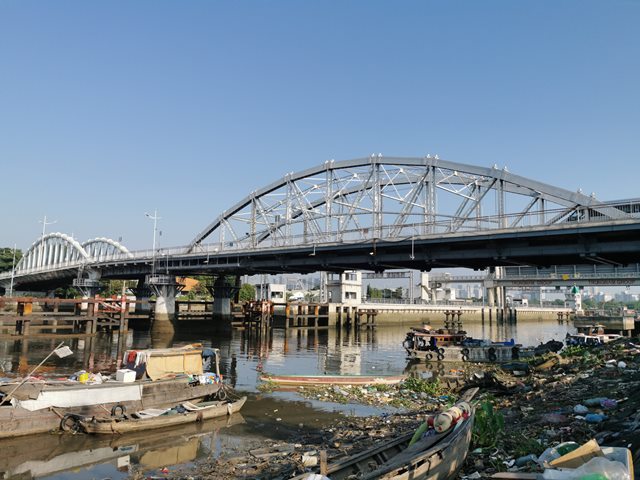
Primary Photographer(s): Nathan Holth
Bridge Documented: November 26, 2018 - January 27, 2024
Nguyễn Tất Thành and Huỳnh Tấn Phát Over Te Channel (Kênh Tẻ)
Ho Chi Minh City (Thành phố Hồ Chí Minh) (Sài Gòn): Ho Chi Minh City (Thành phố Hồ Chí Minh) (Sài Gòn): Vietnam (Việt Nam)
Not Available or Not Applicable
180.0 Feet (54.9 Meters)
675.0 Feet (205.7 Meters)
22 Feet (6.71 Meters)
1 Main Span(s) and 5 Approach Span(s)
Not Applicable

View Information About HSR Ratings
Bridge Documentation
Cầu Tân Thuận is a bridge located in Ho Chi Minh City between District 7 and 4 and today carries one-way traffic alongside a modern bridge which handles the other direction of traffic. Cầu Tân Thuận was a French-built bridge completed in 1905. The bridge is a bit of a mystery because it appears the short central span of the bridge was originally designed as a very small, simple (perhaps even manually operated) bascule span. However not enough historical photos could be found to confirm this. The “mystery span” consists of a riveted deck plate girder, with welded plate added at the center of the span to eliminate the original variable-depth design of the girder. The girders extend beyond the piers under the adjacent spans, which could have accommodated a counterweight system for a bascule. A historical photo taken during the Vietnam War in 1968-9 shows this span having been supplemented with a temporary Bailey truss structure. The original girders in this photo can be seen without the welded plate added, showing the original cantilevered design which strongly resemble bascule leaves. While some catwalks are visible under the bridge, no machinery is visible to confirm the bascule design. There is the possibility that this span was built as a fixed girder, but in such a way that it could have been converted to a bascule span at a later date if marine needs arose. The other spans of Cầu Tân Thuận are also of note, and include a rare concrete bowstring-like truss span, and a European style riveted bowstring through truss span.
Span length and bridge length is an estimate. From west two east, there is two concrete t-beam spans, one 150 foot concrete bowstring span, one 85 foot deck plate girder span, one 180 foot steel bowstring span, and one 135 foot concrete bowstring span.
Above: Historical postcard showing original design of bridge.
Above: Deck plate girder span as seen in 1967. The plate girder still retains its original design including lattice fascia beam and variable depth girder design. A load-bearing Bailey truss has been added to the top, potentially to handle the heavy loads of military vehicles such as the tank visible in the photo.
Above: Deck plate girder span as seen from on a concrete bowstring span in 1968-9. A load-bearing Bailey truss has been added to the top of the deck plate girder span, potentially to handle the heavy loads of military vehicles.
![]()
Photo Galleries and Videos: Cầu Tân Thuận (Tan Thuan Bridge)
Structure Overview
Original / Full Size PhotosA collection of overview photos that show the bridge as a whole and general areas of the bridge. This gallery offers photos in the highest available resolution and file size in a touch-friendly popup viewer.
Alternatively, Browse Without Using Viewer
![]()
Structure Details
Original / Full Size PhotosA collection of detail photos that document the parts, construction, and condition of the bridge. This gallery offers photos in the highest available resolution and file size in a touch-friendly popup viewer.
Alternatively, Browse Without Using Viewer
![]()
Structure Overview
Mobile Optimized PhotosA collection of overview photos that show the bridge as a whole and general areas of the bridge. This gallery features data-friendly, fast-loading photos in a touch-friendly popup viewer.
Alternatively, Browse Without Using Viewer
![]()
Structure Details
Mobile Optimized PhotosA collection of detail photos that document the parts, construction, and condition of the bridge. This gallery features data-friendly, fast-loading photos in a touch-friendly popup viewer.
Alternatively, Browse Without Using Viewer
![]()
Unorganized Photos
Original / Full Size PhotosA collection of overview and detail photos, presented as an unorganized and unlabeled collage and gallery. This gallery offers photos in the highest available resolution and file size in a touch-friendly popup viewer.
Alternatively, Browse Without Using Viewer
![]()
Unorganized Photos
Mobile Optimized PhotosA collection of overview and detail photos, presented as an unorganized and unlabeled collage and gallery. This gallery features data-friendly, fast-loading photos in a touch-friendly popup viewer.
Alternatively, Browse Without Using Viewer
![]()
GoPro: Under, Beside, and Over Bridge
Full Motion VideoNote: The downloadable high quality version of this video (available on the video page) is well worth the download since it offers excellent 4K detail and is vastly more impressive than the compressed streaming video. Streaming video of the bridge. Also includes a higher quality downloadable video for greater clarity or offline viewing.
![]()
Maps and Links: Cầu Tân Thuận (Tan Thuan Bridge)
Coordinates (Latitude, Longitude):
Search For Additional Bridge Listings:
Additional Maps:
Google Streetview (If Available)
GeoHack (Additional Links and Coordinates)
Apple Maps (Via DuckDuckGo Search)
Apple Maps (Apple devices only)
Android: Open Location In Your Map or GPS App
Flickr Gallery (Find Nearby Photos)
Wikimedia Commons (Find Nearby Photos)
Directions Via Sygic For Android
Directions Via Sygic For iOS and Android Dolphin Browser

